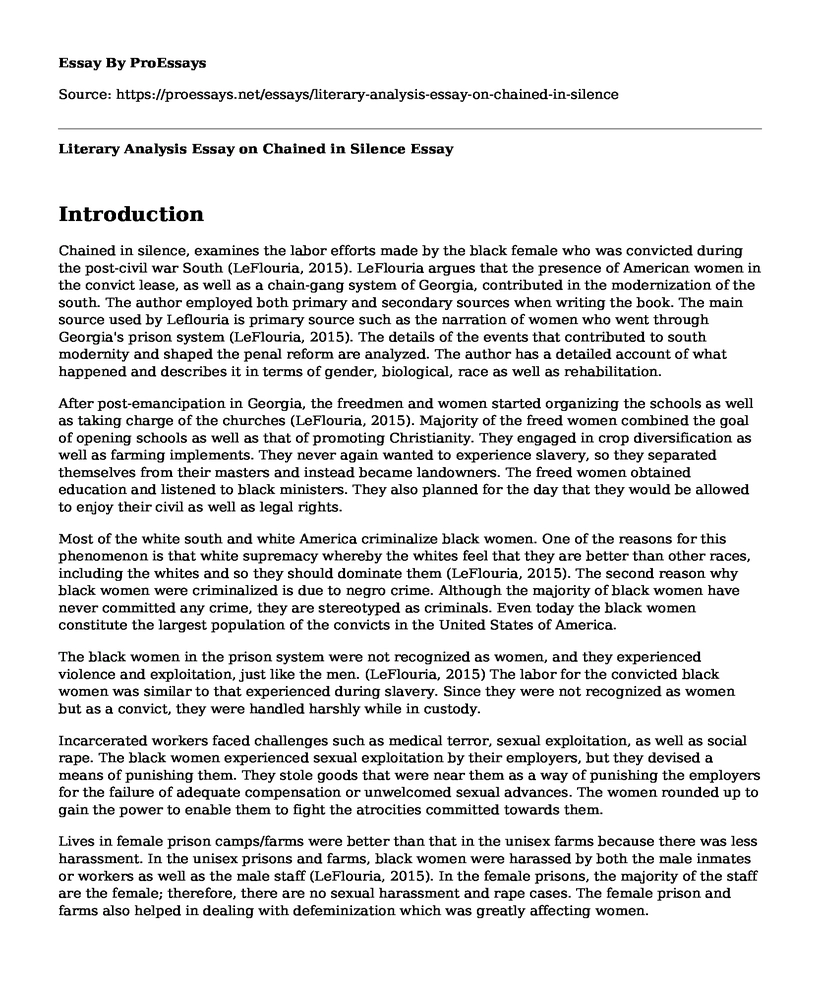Introduction
Chained in silence, examines the labor efforts made by the black female who was convicted during the post-civil war South (LeFlouria, 2015). LeFlouria argues that the presence of American women in the convict lease, as well as a chain-gang system of Georgia, contributed in the modernization of the south. The author employed both primary and secondary sources when writing the book. The main source used by Leflouria is primary source such as the narration of women who went through Georgia's prison system (LeFlouria, 2015). The details of the events that contributed to south modernity and shaped the penal reform are analyzed. The author has a detailed account of what happened and describes it in terms of gender, biological, race as well as rehabilitation.
After post-emancipation in Georgia, the freedmen and women started organizing the schools as well as taking charge of the churches (LeFlouria, 2015). Majority of the freed women combined the goal of opening schools as well as that of promoting Christianity. They engaged in crop diversification as well as farming implements. They never again wanted to experience slavery, so they separated themselves from their masters and instead became landowners. The freed women obtained education and listened to black ministers. They also planned for the day that they would be allowed to enjoy their civil as well as legal rights.
Most of the white south and white America criminalize black women. One of the reasons for this phenomenon is that white supremacy whereby the whites feel that they are better than other races, including the whites and so they should dominate them (LeFlouria, 2015). The second reason why black women were criminalized is due to negro crime. Although the majority of black women have never committed any crime, they are stereotyped as criminals. Even today the black women constitute the largest population of the convicts in the United States of America.
The black women in the prison system were not recognized as women, and they experienced violence and exploitation, just like the men. (LeFlouria, 2015) The labor for the convicted black women was similar to that experienced during slavery. Since they were not recognized as women but as a convict, they were handled harshly while in custody.
Incarcerated workers faced challenges such as medical terror, sexual exploitation, as well as social rape. The black women experienced sexual exploitation by their employers, but they devised a means of punishing them. They stole goods that were near them as a way of punishing the employers for the failure of adequate compensation or unwelcomed sexual advances. The women rounded up to gain the power to enable them to fight the atrocities committed towards them.
Lives in female prison camps/farms were better than that in the unisex farms because there was less harassment. In the unisex prisons and farms, black women were harassed by both the male inmates or workers as well as the male staff (LeFlouria, 2015). In the female prisons, the majority of the staff are the female; therefore, there are no sexual harassment and rape cases. The female prison and farms also helped in dealing with defeminization which was greatly affecting women.
The most interesting thing in the book "Chained in Silence" is the narrative of a black female who went through Georgia's prison system. They suffered greatly in the hands of the male staff and struggled to avoid harassment (LeFlouria, 2015). They went through violence because they were not recognized as women. "Massie was raped repeatedly raped by the bosses. "Additionally, they were viewed as criminals and were unfairly treated by the whites who felt they were superior.
References
LeFlouria, T. L. (2015). Chained in Silence: Black Women and Convict Labor in the New South. UNC Press Books.
Cite this page
Literary Analysis Essay on Chained in Silence. (2023, Feb 15). Retrieved from https://proessays.net/essays/literary-analysis-essay-on-chained-in-silence
If you are the original author of this essay and no longer wish to have it published on the ProEssays website, please click below to request its removal:
- Essay Sample on Restorative Justice
- Critical Essay on The Road Not Taken: A Poem of Choices
- Outpatient Care: A Closer Look at the Revolutionizing Healthcare System - Essay Sample
- Essay Example on Prisons Should Not Be Privatized: Punishment Not Profit
- Death Penalty: A Necessary Deterrent for Serious Offenses? - Essay Sample
- Gun Control: Divisive Issue in US, Analysis of Article - Essay Sample
- Paper Example on Hope's Feather: Emily Dickinson's Poem







